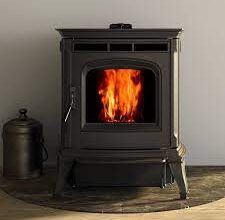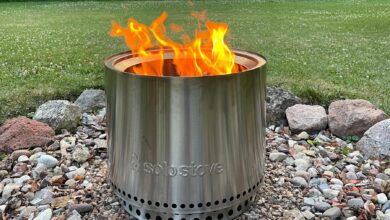Electric Stove: The Ultimate Guide to Choosing, Using, and Maintaining 2024

Introduction to Electric Stoves
Electric stoves have become a staple in many kitchens, thanks to their reliability, ease of use, and energy efficiency. In today’s market, offer a modern cooking solution that is increasingly popular for households looking for convenience and safety.
What is an Electric Stove?
An electric stove is a kitchen appliance designed for cooking that uses electricity as its energy source instead of gas. Unlike traditional gas stoves, which require a constant fuel supply, convert electrical energy into heat, allowing for even, controllable cooking temperatures. The cooktops are often available in two main styles: coil burners and smooth ceramic or glass surfaces, with options for traditional or induction heating.
How Do Electric Stoves Work?
Electric stoves work by channeling electricity through a heating element, creating heat that transfers to cookware placed on the burner. This process is regulated by a thermostat, allowing for precise temperature control. Some use induction technology, where magnetic fields generate heat directly within the pot or pan itself, rather than heating the cooktop surface.
Types of Electric Stoves
Electric stoves are available in various styles to meet different needs and preferences:
- Coil Electric Stoves: Known for durability and affordability.
- Smooth-top Electric Stoves: A sleek, easy-to-clean surface.
- Induction Electric Stoves: Offers fast, even cooking through magnetic fields.
- Advantages of Using an Electric Stove
Energy Efficiency
Electric stoves are generally more energy-efficient than their gas counterparts because they transfer nearly all of the energy they consume directly to the cookware. This not only speeds up the cooking process but also conserves energy, reducing utility costs over time.
Temperature Control

One of the standout features of is the level of temperature control they offer. With precise heat settings, users can easily adjust cooking temperatures for various recipes, making ideal for delicate cooking tasks.
Safety Benefits
Electric stoves are often considered safer than gas stoves. There is no risk of gas leaks, and many models come equipped with safety features like automatic shut-off and child locks. Additionally, induction don’t heat the cooktop itself, reducing the risk of accidental burns.
- Types of Electric Stoves
Coil Electric Stoves
Coil stoves are the traditional choice and feature exposed coils that heat up when electricity flows through them. They’re known for durability and tend to be more budget-friendly, though they can be harder to clean compared to smooth-top models.
Smooth-top Electric Stoves
Smooth-top stoves have a flat, easy-to-clean surface, typically made from glass or ceramic. These stoves distribute heat evenly and offer a sleek, modern look. However, the surface is delicate and can scratch or crack if not properly maintained.
Induction Electric Stoves
Induction stoves use magnetic fields to create heat directly within the cookware rather than the cooktop itself. This results in faster heating, greater energy efficiency, and safer cooking. Induction stoves, however, require compatible cookware, which can be a limitation for some users.
- Electric Stove vs. Gas Stove: Which is Better?
Cooking Performance Comparison
While both electric and gas stoves have their merits, offer more consistent heating. Gas stoves provide instant heat, but maintain a steady temperature, which is crucial for recipes requiring precise cooking conditions.
Cost-Effectiveness
Electric stoves generally have a lower upfront cost compared to gas stoves, though operational costs depend on local electricity and gas prices. Over time, can be more economical due to their energy efficiency.
Environmental Impact
Electric stoves produce fewer emissions than gas stoves, making them an environmentally friendly choice. For households looking to reduce their carbon footprint, are an excellent option, especially when paired with renewable energy sources.
- Key Features to Look for in an Electric Stove
Temperature Control Features
Modern come with digital displays, dials, and touch controls that allow precise temperature settings. Some high-end models even offer smart technology, letting users control the stove remotely via smartphone apps.
Cleaning Ease
Smooth-top electric stoves are often easier to clean than coil models. For coil stoves, removable parts make deep cleaning possible. Look for models with self-cleaning ovens to reduce maintenance time and effort.
Energy Efficiency
Energy efficiency is a crucial factor to consider. Some are ENERGY STAR certified, indicating they meet high standards for conserving electricity. Opting for an energy-efficient model can lead to long-term savings.
- How to Choose the Right Electric Stove for Your Kitchen
Kitchen Size Considerations

The size of your kitchen and the available space for the stove are essential considerations. Smaller kitchens may benefit from a compact model, while larger kitchens can accommodate standard or even double-oven stoves.
Cooking Needs
Your cooking habits should also influence your choice. If you regularly prepare large meals, a stove with multiple burners or a double oven may be ideal. For occasional cooking, a basic model may suffice.
Budget Planning
Electric stoves vary significantly in price. Setting a budget helps narrow down your options and ensures you find a model with essential features without overspending.
- Installation Guide for Electric Stoves
Basic Requirements
require a 220-240V outlet, and it’s crucial to ensure your kitchen wiring can support this. Checking the electrical setup before installation is essential for safety and functionality.
Common Installation Mistakes to Avoid
Improper leveling is a common mistake, leading to uneven cooking. Ensure the stove is level and that the power cord is properly grounded to avoid electrical issues.
Professional Installation vs. DIY
While some users may choose DIY installation, hiring a professional is recommended for those unfamiliar with electrical work. A professional installation ensures that the stove is set up correctly and safely.
- How to Use an Electric Stove Safely and Effectively
Preheating Tips
Preheating is essential for even cooking, especially when baking. Allow your to reach the desired temperature before placing your food in the oven or pan.
Proper Pan Usage
For best results, use flat-bottomed cookware that matches the burner size to ensure even heat distribution. Avoid oversized or warped pans, which can lead to uneven cooking and damage the cooktop.
Avoiding Overheating
Overheating can damage the cooktop and cookware. Keep an eye on the temperature settings and avoid using high heat for extended periods to prevent unnecessary wear and tear.
- Maintenance Tips for Electric Stoves
Cleaning the Surface
Regularly wipe down the cooktop with a soft cloth to prevent residue buildup. For smooth-top stoves, use a non-abrasive cleaner to avoid scratching the surface.
Handling Burnt-on Spills
Spills can be challenging to remove if left to harden. For tough spots, a mixture of baking soda and water often does the trick, while ceramic cooktop scrapers are effective for smooth surfaces.
Coil and Smooth-top Maintenance
For coil stoves, occasionally remove and clean the coils to maintain heating efficiency. Smooth-top stoves benefit from regular polish with a ceramic-friendly cleaner.
- Troubleshooting Common Electric Stove Issues
Burner Won’t Heat
If a burner isn’t heating, the issue could be with the burner itself, the socket, or the wiring. First, check the connection; if the problem persists, a replacement part may be needed.
Stove Won’t Turn On
For stoves that won’t power on, first, check the electrical outlet and breaker box. If these are functioning correctly, a professional may be needed to assess potential internal faults.
Uneven Heating Issues
Uneven heating is typically due to misaligned burners or an unlevel stove. Ensuring proper installation and regular maintenance can often resolve this issue.
- Electric Stove Efficiency and Energy-Saving Tips
Reducing Energy Costs
Minimize cooking times and keep the oven door closed as much as possible to reduce energy loss. Also, consider using the residual heat after turning the stove off for additional cooking.
Efficient Cooking Techniques
Use lids on pots to trap heat and cook foods faster. When using the oven, cook multiple dishes simultaneously to maximize energy use.
Insulating the Stove Area
Insulating around the stove area, particularly if placed near windows or doors, can help conserve heat and reduce energy waste.
- Best Electric Stove Brands and Models in 2023
Top-Rated Brands
Brands like GE, Whirlpool, and Samsung are well-regarded for their durability and performance. These brands offer a range of models suitable for different budgets and preferences.
Popular Models
The GE Profile, Samsung Flex Duo, and Whirlpool Smart Slide-In are popular for their advanced features and reliability. Many models come with Wi-Fi connectivity and voice control for added convenience.
Price Range Overview
Electric stoves vary from $300 for basic models to $3,000+ for premium options with smart features. Comparing features and reviews can help find a suitable stove within your budget.
- Electric Stove Safety Tips for Families with Kids
Child-Proofing
Consider installing child locks and knob covers to prevent accidental adjustments by curious children. Some models come with built-in child-lock features for added safety.
Stove Guard Installation
Stove guards are helpful in creating a barrier between the hot surface and small hands. This accessory is especially useful for smooth-top, where the surface remains hot after use.
Education for Kids
Teach children about the potential dangers of hot surfaces and emphasize safe behaviors in the kitchen, reducing the risk of accidents.
- Accessories and Tools to Enhance Your Electric Stove Experience
Specialty Pans and Cookware
Certain cookware materials, like cast iron and stainless steel, work exceptionally well with. Investing in quality cookware can improve cooking efficiency and results.
Stove Protectors
Stove protectors, such as burner covers and spill guards, are useful for maintaining a clean cooktop and prolonging the stove’s life. These accessories are especially valuable for coil.
Thermometers and Timers
Digital thermometers and timers make precise cooking easy, helping avoid overcooking or undercooking. Many electric stoves come with built-in timers, but standalone options can offer more versatility.
- FAQ about Electric Stoves
- Do cook as well as gas stoves?
Yes, electric stoves offer consistent and even cooking temperatures. While gas stoves provide quick, direct heat, excel in maintaining steady heat, ideal for slow cooking.
- Are electric stoves expensive to operate?
Electric stoves are energy-efficient, and operating costs are generally reasonable, especially with ENERGY STAR-rated models. Comparing local gas and electricity rates can help assess operating costs.
- Can I use any cookware on an induction electric stove?
Induction stoves require magnetic cookware, such as stainless steel or cast iron. Non-magnetic materials, like aluminum or glass, won’t work unless combined with an induction adapter.
- How long do electric stoves typically last?
have a lifespan of 13 to 15 years, depending on usage and maintenance. Regular cleaning and proper use can help extend the life of an.
- Are electric stoves safe to leave on for extended periods?
While most have built-in safety features, avoid leaving them unattended for long periods. Consider models with automatic shut-off for added safety.
- Can I replace my gas stove with an electric stove?
Yes, replacing a gas stove with an electric model is possible, but it requires adequate wiring. Consulting a professional electrician is recommended for safe installation.



